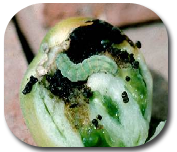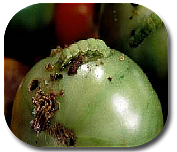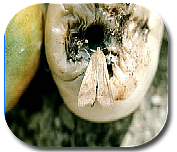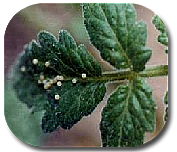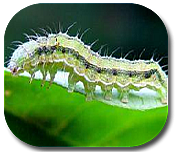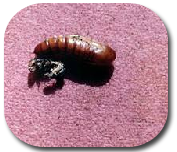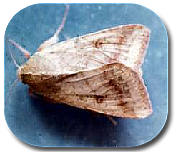Identification of pest:
- Eggs: Eggs are sculptured and creamy white in colour, laid singly
- Larva: Shows colour variation from greenish to brown. It has dark brown grey lines on the body with lateral white lines and also has dark band
- Pupa: Brown in colour, occurs in soil, leaf, pod and crop debris
- Adult: Female light pale brownish yellow stout moth, Male – Pale greenish moth V shaped speck.
- Forewing: olive green to pale brown with a dark brown circular spot in the centre
- Hindwing: is pale smoky white with a broad blackish outer margin
Management:
- Collect and destroy the infected fruits and grown up larvae
- Grow simultaneously 40 days old American tall marigold and 25 days old tomato seedling at 1:16 rows
- Setup pheromone trap with Helilure at 12/ha
- Collection and destroy of damaged fruits and grown up caterpillars.
- Release Trichogramma pretiosum @ 1 lakh/ha at an interval of 7 days starting from flower initiation stage.
- Spray HaNPV 1.5 x 1012 POBs/ha.
- For Helicoverpa armigera: HaNPV 1.5 x 1012 POBs/ha i.e. NPV of H. armigera 0.43% AS @ 3.0 ml/lit or 2 % AS @ 1.0 ml per lit
- For Spodoptera litura: Sl NPV 1.5 x 1012 POBs/ha
- Provide poison bait with carbaryl 50 WP 1.25 kg, rice bran 12.5 kg, jaggery 1.25 kg and water 7.5 lit/ha
- Spray Bacillus thuringiensis 2g/lit or any one of the following insecticide
- Spray Azadirachtin 1.0 % EC (10000 ppm) 2.0 ml/ lit. or apply Bacillus thuringiensis 2g/lit. during evening hours.
|
| Insecticide |
Dose |
| Indoxacarb 14.5 SC |
8 ml/ 10 lit |
| Flubendiamide 39.35 SC |
2 ml/10 lit |
| Flubendiamide 20 WG |
2 g/10 lit |
| Novaluron 10 % EC |
7.5 ml/10 lit |
| Phosalone 35 % EC |
13 ml/10 lit |
| Quinalphos 25 % EC |
1.0 ml/ lit |
| Chlorantraniliprole 18.5 SC |
3.0 ml/ 10 lit |
| Cyantraniliprole 10.26 OD |
18 ml/ 10 lit |
|

